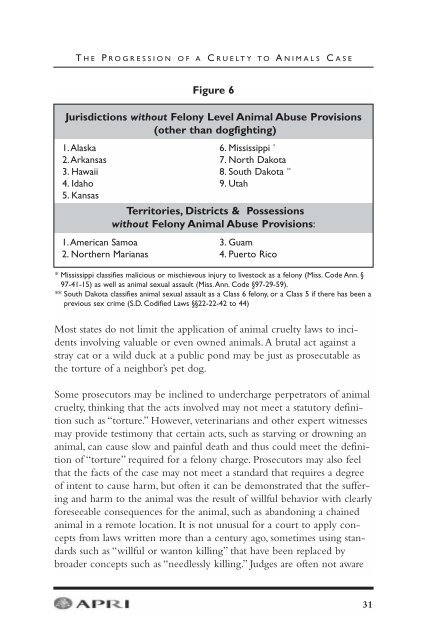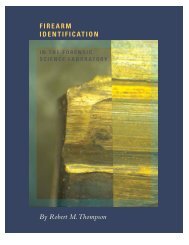Animal Cruelty Prosecution Animal Cruelty Prosecution
Animal Cruelty Prosecution Animal Cruelty Prosecution
Animal Cruelty Prosecution Animal Cruelty Prosecution
Create successful ePaper yourself
Turn your PDF publications into a flip-book with our unique Google optimized e-Paper software.
T HE P R OGRESSION OF A C R UELTY TO A NIMALS C ASE<br />
Jurisdictions without Felony Level <strong>Animal</strong> Abuse Provisions<br />
(other than dogfighting)<br />
1.Alaska<br />
2.Arkansas<br />
3. Hawaii<br />
4. Idaho<br />
5. Kansas<br />
1.American Samoa<br />
2. Northern Marianas<br />
Figure 6<br />
6. Mississippi *<br />
7. North Dakota<br />
8. South Dakota **<br />
9. Utah<br />
Territories, Districts & Possessions<br />
without Felony <strong>Animal</strong> Abuse Provisions:<br />
3. Guam<br />
4. Puerto Rico<br />
* Mississippi classifies malicious or mischievous injury to livestock as a felony (Miss. Code Ann. §<br />
97-41-15) as well as animal sexual assault (Miss.Ann. Code §97-29-59).<br />
** South Dakota classifies animal sexual assault as a Class 6 felony, or a Class 5 if there has been a<br />
previous sex crime (S.D. Codified Laws §§22-22-42 to 44)<br />
Most states do not limit the application of animal cruelty laws to incidents<br />
involving valuable or even owned animals. A brutal act against a<br />
stray cat or a wild duck at a public pond may be just as prosecutable as<br />
the torture of a neighbor’s pet dog.<br />
Some prosecutors may be inclined to undercharge perpetrators of animal<br />
cruelty, thinking that the acts involved may not meet a statutory definition<br />
such as “torture.” However, veterinarians and other expert witnesses<br />
may provide testimony that certain acts, such as starving or drowning an<br />
animal, can cause slow and painful death and thus could meet the definition<br />
of “torture” required for a felony charge. Prosecutors may also feel<br />
that the facts of the case may not meet a standard that requires a degree<br />
of intent to cause harm, but often it can be demonstrated that the suffering<br />
and harm to the animal was the result of willful behavior with clearly<br />
foreseeable consequences for the animal, such as abandoning a chained<br />
animal in a remote location. It is not unusual for a court to apply concepts<br />
from laws written more than a century ago, sometimes using standards<br />
such as “willful or wanton killing” that have been replaced by<br />
broader concepts such as “needlessly killing.” Judges are often not aware<br />
31







